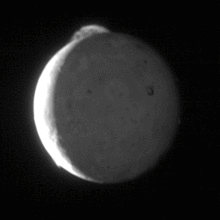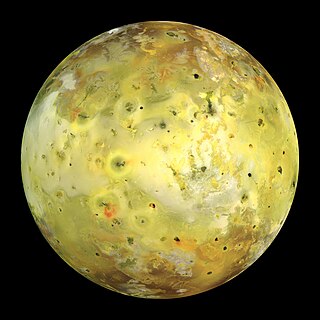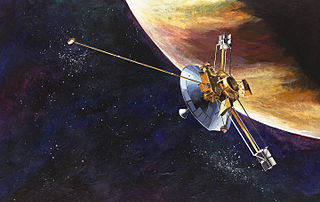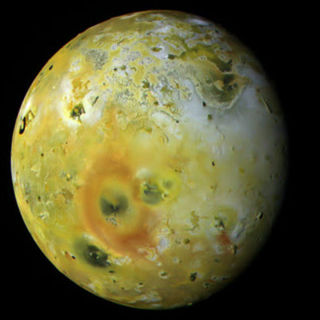Goals and objectives
| | This section is empty. You can help by adding to it. (September 2019) |

| Names | FIRE |
|---|---|
| Mission type | Reconnaissance |
| Operator | NASA/JPL |
| Mission duration | cruise: 6 years science phase: 4 months (proposed) [1] |
| Start of mission | |
| Launch date | 2024 (proposed) |
| Rocket | Atlas V |
| Flyby of Io | |
| Closest approach | 2030 (proposed) |
| Distance | 100 km from Io |
| Orbits | ≥10 Io flybys |
FIRE (Flyby of Io with Repeat Encounters) is a concept mission to Jupiter's innermost major moon Io. The mission was first presented in 2012 [2] for a possible future consideration by NASA's New Frontiers program. [3]
If developed in the future, the FIRE spacecraft would use three gravity assists to reach Jupiter six years later. [3] The spacecraft would orbit Jupiter and perform 10 flybys of Io, some as low as 100 km (62 mi) from its surface. [3] [1] The ten flybys would be completed in approximately four months. [1]
As a New Frontiers class mission, the cost cap would be $991 million (FY2012) with a $927 million base cap with a $64 million launch vehicle cost credit. [1]
| | This section is empty. You can help by adding to it. (September 2019) |


The instrument suite includes four proposed instruments: [2] [3]
Electric power to the spacecraft and its scientific payload would be generated by three Advanced Stirling Radioisotope Generators (ASRG). [3] [1] ASRG is a radioisotope power system under development at NASA's Glenn Research Center. It uses a Stirling power conversion technology to convert radioactive-decay heat into electricity for use on spacecraft.

Galileo was an American robotic space program that studied the planet Jupiter and its moons, as well as several other Solar System bodies. Named after the Italian astronomer Galileo Galilei, the Galileo spacecraft consisted of an orbiter and an entry probe. It was delivered into Earth orbit on October 18, 1989 by Space ShuttleAtlantis on the STS-34 mission, and arrived at Jupiter on December 7, 1995, after gravitational assist flybys of Venus and Earth, and became the first spacecraft to orbit Jupiter. It launched the first probe into Jupiter, directly measuring its atmosphere. Despite suffering major antenna problems, Galileo achieved the first asteroid flyby, of 951 Gaspra, and discovered the first asteroid moon, Dactyl, around 243 Ida. In 1994, Galileo observed Comet Shoemaker–Levy 9's collision with Jupiter.

Pioneer 10 is a NASA space probe launched in 1972 that completed the first mission to the planet Jupiter. Pioneer 10 became the first of five planetary probes and 11 artificial objects to achieve the escape velocity needed to leave the Solar System. This space exploration project was conducted by the NASA Ames Research Center in California. The space probe was manufactured by TRW Inc.

Io, or Jupiter I, is the innermost and third-largest of the four Galilean moons of the planet Jupiter. Slightly larger than Earth's moon, Io is the fourth-largest moon in the Solar System, has the highest density of any moon, the strongest surface gravity of any moon, and the lowest amount of water of any known astronomical object in the Solar System. It was discovered in 1610 by Galileo Galilei and was named after the mythological character Io, a priestess of Hera who became one of Zeus's lovers.

Juno is a NASA space probe orbiting the planet Jupiter. It was built by Lockheed Martin and is operated by NASA's Jet Propulsion Laboratory. The spacecraft was launched from Cape Canaveral Air Force Station on August 5, 2011 UTC, as part of the New Frontiers program. Juno entered a polar orbit of Jupiter on July 5, 2016, UTC, to begin a scientific investigation of the planet. After completing its mission, Juno will be intentionally deorbited into Jupiter's atmosphere.
The New Frontiers program is a series of space exploration missions being conducted by NASA with the purpose of furthering the understanding of the Solar System. The program selects medium-class missions which can provide high science returns.

The exploration of Jupiter has been conducted via close observations by automated spacecraft. It began with the arrival of Pioneer 10 into the Jovian system in 1973, and, as of 2023, has continued with eight further spacecraft missions in the vicinity of Jupiter. All of these missions were undertaken by the National Aeronautics and Space Administration (NASA), and all but two were flybys taking detailed observations without landing or entering orbit. These probes make Jupiter the most visited of the Solar System's outer planets as all missions to the outer Solar System have used Jupiter flybys. On 5 July 2016, spacecraft Juno arrived and entered the planet's orbit—the second craft ever to do so. Sending a craft to Jupiter is difficult, mostly due to large fuel requirements and the effects of the planet's harsh radiation environment.

The exploration of Uranus has, to date, been through telescopes and a lone probe by NASA's Voyager 2 spacecraft, which made its closest approach to Uranus on January 24, 1986. Voyager 2 discovered 10 moons, studied the planet's cold atmosphere, and examined its ring system, discovering two new rings. It also imaged Uranus' five large moons, revealing that their surfaces are covered with impact craters and canyons.

Pele is an active volcano on the surface of Jupiter's moon Io. It is located on Io's trailing hemisphere at 18.7°S 255.3°W. A large, 300-kilometer (190 mi) tall volcanic plume has been observed at Pele by various spacecraft starting with Voyager 1 in 1979, though it has not been persistent. The discovery of the Pele plume on March 8, 1979 confirmed the existence of active volcanism on Io. The plume is associated with a lava lake at the northern end of the mountain Danube Planum. Pele is also notable for a persistent, large red ring circling the volcano resulting from sulfurous fallout from the volcanic plume.

The advanced Stirling radioisotope generator (ASRG) is a radioisotope power system first developed at NASA's Glenn Research Center. It uses a Stirling power conversion technology to convert radioactive-decay heat into electricity for use on spacecraft. The energy conversion process used by an ASRG is significantly more efficient than previous radioisotope systems, using one quarter of the plutonium-238 to produce the same amount of power.

Surt is an active volcano on Jupiter's moon Io. It is located on Io's Jupiter-facing hemisphere at 45.21°N 336.49°W. Surt consists of an oblong volcanic pit, 75 by 40 kilometres in diameter, surrounded by reddish sulfur and bright sulfur dioxide deposits to its south and east. The volcano was first observed in images acquired by the Voyager 1 spacecraft in March 1979. Later that year, the International Astronomical Union named this feature after Surtr, a leader of the fire giants of Norse mythology.

Masubi is an active volcano on Jupiter's moon Io. It is located on Io's leading hemisphere at 49.6°S 56.18°W within a bright terrain region named Tarsus Regio. A volcanic plume has been observed at Masubi by various spacecraft starting with Voyager 1 in 1979, though it has not been persistent like similar Ionian volcanoes Amirani and Prometheus. Masubi is also notable for having one of the largest active lava flows on Io, with an additional 240 km (150 mi) flow forming between 1999 and 2007.

Tupan Patera is an active volcano on Jupiter's moon Io. It is located on Io's anti-Jupiter hemisphere at 18.73°S 141.13°W. Tupan consists of a volcanic crater, known as a patera, 79 kilometers across and 900 meters deep. The volcano was first seen in low-resolution observations by the two Voyager spacecraft in 1979, but volcanic activity was not seen at this volcano until June 1996 during the Galileo spacecraft's first orbit. Following this first detection of near-infrared thermal emission and subsequent detections by Galileo during the next few orbits, this volcano was formally named Tupan Patera, after the thunder god of the Tupí-Guaraní indigenous peoples in Brazil, by the International Astronomical Union in 1997.

Tawhaki Patera is an active volcano on Jupiter's moon Io. It is located on Io's leading hemisphere at 3.32°N 76.18°W within the equatorial plains of western Media Regio. Tawhaki is an Ionian patera, a type of volcanic crater similar to a caldera, 49.8 kilometers (30.9 mi) wide and 550 meters (1,800 ft) deep.
Io Volcano Observer (IVO) is a proposed low-cost, outer-planet mission to explore Jupiter's moon Io to understand tidal heating as a fundamental planetary process. The main science goals are to understand (A) how and where tidal heat is generated inside Io, (B) how tidal heat is transported to the surface, and (C) how Io is evolving. These results are expected to have direct implications for the thermal history of Europa and Ganymede as well as provide insights into other tidally heated worlds such as Titan and Enceladus. The IVO data may also improve our understanding of magma oceans and thus the early evolution of the Earth and Moon.

The exploration of Io, Jupiter's innermost Galilean and third-largest moon, began with its discovery in 1610 and continues today with Earth-based observations and visits by spacecraft to the Jupiter system. Italian astronomer Galileo Galilei was the first to record an observation of Io on January 8, 1610, though Simon Marius may have also observed Io at around the same time. During the 17th century, observations of Io and the other Galilean satellites helped with the measurement of longitude by map makers and surveyors, with validation of Kepler's Third Law of planetary motion, and with measurement of the speed of light. Based on ephemerides produced by astronomer Giovanni Cassini and others, Pierre-Simon Laplace created a mathematical theory to explain the resonant orbits of three of Jupiter's moons, Io, Europa, and Ganymede. This resonance was later found to have a profound effect on the geologies of these moons. Improved telescope technology in the late 19th and 20th centuries allowed astronomers to resolve large-scale surface features on Io as well as to estimate its diameter and mass.

Thor is an active volcano on Jupiter's moon Io. It is located on Io's anti-Jupiter hemisphere at 39.15°N 133.14°W. A major eruption with high thermal emission and a large, volcanic plume was observed during a Galileo flyby on August 6, 2001, when the spacecraft flew through the outer portions of the plume allowing for direct sampling. The eruption continued into Galileo's next flyby in October 2001. As seen during high-resolution images taken during the eruption, Thor consists of a series of dark lava flows emanating from a set of nearby volcanic depressions. Before the eruption, the area consisted of red-brown plains, composed of irradiated sulfur, typical of Io's mid- to high-northern latitudes and a set of yellow flows, possibly consisting of sulfur or silicate flows covered by diffuse sulfur deposits. During the New Horizons encounter in February 2007, Thor was still active, with the spacecraft observing thermal emission in the near-infrared and a volcanic plume at the volcano.

Argo was a 2009 spacecraft mission concept by NASA to the outer planets and beyond. The concept included flybys of Jupiter, Saturn, Neptune, and a Kuiper belt object. A focus on Neptune and its largest moon Triton would have helped answer some of the questions generated by Voyager 2's flyby in 1989, and would have provided clues to ice giant formation and evolution.

The timeline of the Galileo spacecraft spans its launch in 1989 to the conclusion of its mission when it dove into and destroyed itself in the atmosphere of Jupiter in 2003.

OCEANUS is a mission concept conceived in 2016 and presented in 2017 as a potential future contestant as a New Frontiers program mission to the planet Uranus. The concept was developed by the Astronautical engineering students of Purdue University during the 2017 NASA/JPL Planetary Science Summer School. OCEANUS is an orbiter, which would enable a detailed study of the structure of the planet's magnetosphere and interior structure that would not be possible with a flyby mission.
Camilla is a spacecraft and mission concept proposed for NASA’s New Frontiers program. It would be a centaur exploration mission, particularly to minor planet 10199 Chariklo. It consists of a flyby craft (Camilla), and tungsten impactor (Halbred).